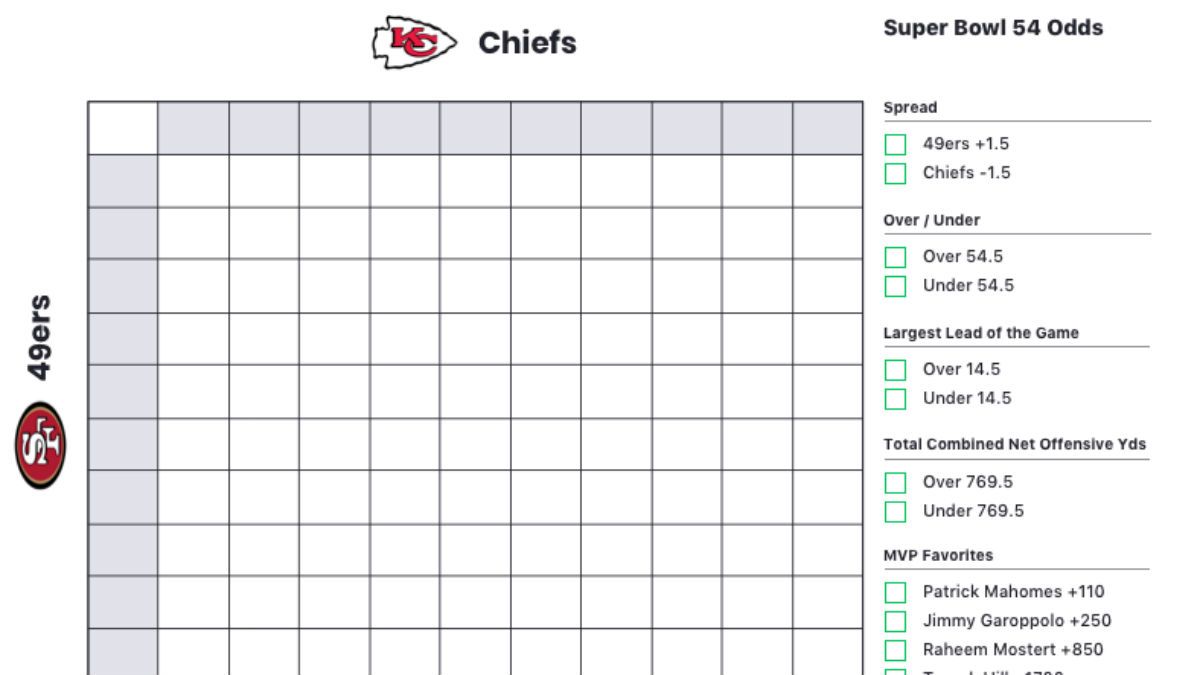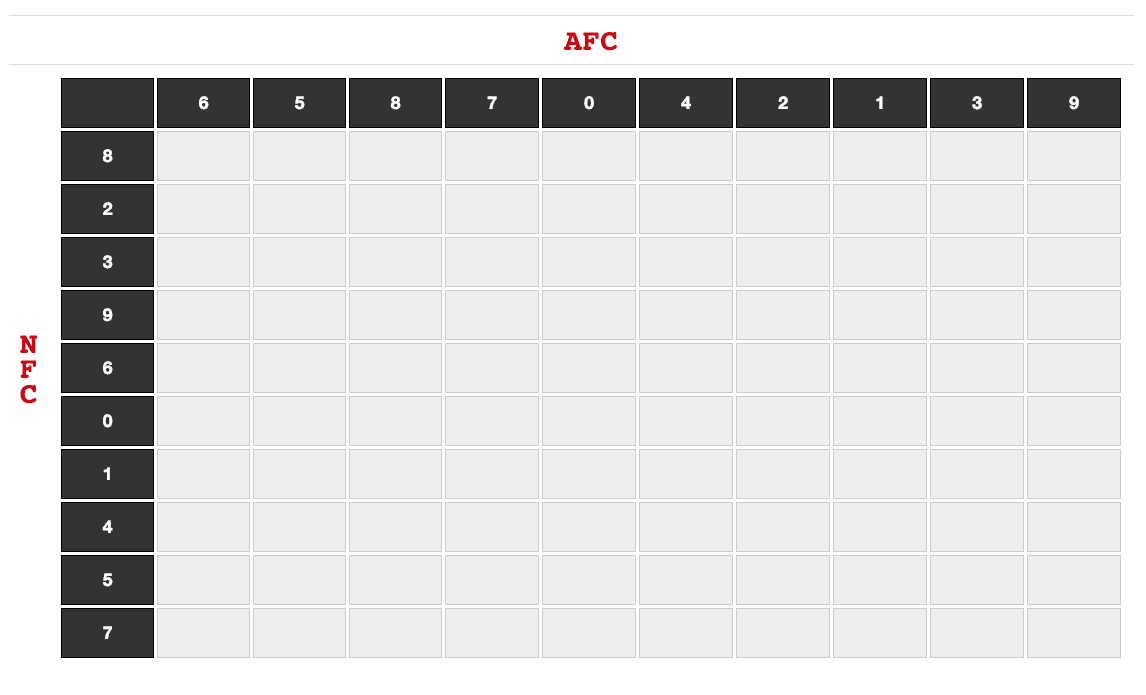How To Play The Square Game For Super Bowl
If you’re a football fan, if your friends follow the NFL, or if you work in an office, chances are you’ve heard of a football pool.

To rise above the average square crowd - rec players need to follow a solid research path and practice proper bankroll management. Both are key to long-term betting success. Both are key to long. The Super Bowl is the annual championship game of the National Football League (NFL). It has served as the final game of every NFL season since 1966, replacing the NFL Championship Game. Since 2004, the game has been played on the first Sunday in February. Winning teams are awarded with Vince.
A football pool using “squares,” typically a 10 x 10 grid, is an easy way to get a group of people to bet on a football game using a random assignment of numbers to names to find out who wins the pot for every quarter.
Unlike other types of sports bets, you don’t need to be an economist or calculate odds or know anything about the teams (or even the sport) to win.
This is a luck-based system, not a skill-based approach, and it’s designed to make a football game more fun and interesting, with some real money on the line.
Football squares pools, are especially popular for the Super Bowl. If you’ve never played before, or want to learn more, here’s our guide on how to play Super Bowl squares.
What Are Football Squares?
Football squares, also known as a football pool or football boxes, is a way of placing bets for a group of people using a basic X-Y axis (remember algebra?) Players enter their names (usually initials) into as many squares as they wish to buy into.
Each square represents a score. At the end of each quarter, the person on the square that corresponds to the score at that time is given his or her share of the prize money.
When playing Super Bowl squares, the winner of each quarter of the big game is typically given a quarter of the money paid into the pool.
The grid used to set up a squares game looks complicated but is actually quite simple to grasp once you get the hang of it. Here’s an example of one.
Essentially, the pool pays out each quarter based on the last digit of the score of each team. For instance, if the score is 17-13, the winner would be the person on the 7-3 square.
How to Set Up Your Super Bowl Squares Grid
Create a grid ten boxes high and ten boxes wide. This will give you 100 boxes, which means you can potentially have 100 people participating in this pool, although usually far fewer people are used.
Over the top of your grid, write the name of one of the teams competing in the Super Bowl.
Vertically, along the left-hand side of the grid, write the name of the other team.
:format(png)/cdn.vox-cdn.com/uploads/chorus_image/image/53096291/SB_squares.0.png)
Although the Super Bowl boxes layout is called a ten by ten, you do need room to write the numbers 0-9 along the top columns, one number for each column, and along the vertical left-hand side of the chart as well.
Here’s how the grids looks once the numbers are filled in.
You can choose not to enter the numbers before people pick their squares, and add them in a random order later instead. This is if you don’t want people to know what scores they are assigning themselves to.
Does the Grid Have to Be 10 x 10?
For the standard version of Super Bowl squares rules, yes. The football pool uses only the last digit of a score (for instance, if the score is Team A – 12, Team B – 15, then the grid would be followed to find out who is at the intersection of Team A – 2 and Team B – 5.
Since the ending numbers of any given score can range from between zero and nine, which includes 10 number options total, there must be 10 squares on each side of the chart.
How Many People Are Needed to Play Super Bowl Squares?
You can create a football pool using this squares method using as few as two people and as many as 100. The fewer people are involved, the more squares they can buy.
If there are 100 people, each person would be able to choose one square. Fifty participants would be able to choose two squares each, and 25 people could have four squares apiece.
However, some people may only wish to buy into one square, while others wish to buy into multiples.
You can limit the number of squares available to each participant until all players have had a chance to buy squares. You can then sell the extra squares to players who wish to play more squares to increase their chances of winning.
If you are playing with an actual sheet of paper, hand the grid around before the numbers are assigned across the top and down the left side.
If you are playing electronically, there are automatic pool fill apps that can scatter the names/initials equally across the board.
What If Squares in the Super Bowl Squares Grid Are Empty?
You may have empty squares on your board. Either only a few people are playing, or there simply wasn’t anyone who wanted that particular square. This is not uncommon.
If the score lands on a space where no one has their name, you can add that money to the prize for the next quarter. Thus, the winner of the next quarter will receive a double payout.
This is entirely up to you and the other participants. A standard buy-in is $5 per square, but it can go as low as $1 per square and as high as you want.

The more people who participate, the higher the energy, and the more fun the squares game is. So you may want to consider a buy-in that will allow as many people as possible to participate.
Yes, players will write their initials in on the squares they choose, but since the numbers along the top and left side of the grid can be entered later, the placement of the names in the squares doesn’t have to be relevant. It just depends on how you want to play.
In the example Super Bowl squares template above, the numbers were in order from 0-9. You can choose to mix the numbers up, though.
For instance, across the top ten squares, in which you will write the digits 0-9, you may choose to array them thus: 2, 4, 1, 0, 9, 5, 8, 6, 7, 3. Do the same vertically.
The reason for doing this is to make the game fairer, and to remove any benefit from those who choose their Super Bowl squares before others. Certain scores are more likely to win than others, so it can be an advantage to avoid those squares.
You can use squares grids to create a pool for any football game, from pee-wee to pro. The rules for Super Bowl squares games remain essentially the same regardless.
You and your friends may be avid Monday Night Football fans and can have a pool every week using the same grid over and over, simply changing the names of the teams on the axis or creating a new grid and placing the names in different squares for each game.
A squares games can be used to enliven a sports-themed bachelor/bachelorette party, a birthday party, or even just having friends over on Sunday for the game. This squares game, which gives all players the same chance to win, caters to football fans and non-fans alike, and in fact pulls non-football fans into the excitement by giving them some stakes in the game.
Squares pools can be used for fundraising (check local laws). You can collect the buy-in for each square, as usual, but instead of paying out the entire intake 1/4 at a time for each quarter, you could pay 1/8 of the “pot” to the winner of each quarter, which leaves you with 1/2 of the funds to give to the charitable cause.
Getting a whole office, club, or team on board with a squares pool is a solid way to team-build and start conversations. It gets people talking about the game, creates relationships, and eases the atmosphere.
You can also play squares for other sports and tournaments. March Madness, for example, or ice hockey.
With some rearrangement of the prize disbursement and how scores are calculated, they can be used for PGA Tour events and even the Olympics.
Learning how to play Super Bowl squares is not that difficult. It doesn’t take much to start a football squares pool.
You just need a piece of paper, or a pre-printed Super Bowl squares template, and some willing participants. It’s a fun way to bet on the Super Bowl among friends.

/cdn.vox-cdn.com/uploads/chorus_asset/file/7929173/SB_squares.png)
How To Play The Square Game For Super Bowl 5 X 5 Squares
Once you’ve explained the rules for playing Super Bowl squares, and got the boxes filled out, your only real work is to watch the game!
There are many people who treat the Super Bowl like it is a national holiday. They dress in their team’s colors and jerseys and go all out with Super Bowl celebrations. A great way to bring the excitement of the Super Bowl to your office or Super Bowl party is to set up a Super Bowl pool! Whether you're are going to try a Super Bowl pool at work or at home, you'll just need to make sure you've got it ready to go by game time.
Here are some easy directions to follow to organize your Super Bowl pool:
How To Play The Square Game For Super Bowl
- Get all of the necessary materials: poster board, marker, and a ruler.
- Make a 10 by 10 grid on the poster, so that you will have 100 square blocks across the board. Be sure to leave room around edges of the board to write numbers and words.
- Write the numbers 0 through 9 along the left side of the grid next to each square. Write the numbers 0 through 9 across the top above each square.
- Write one Super Bowl team’s name across the top of the grid and the other team name along the side of the grid.
- Assign a dollar value to each of the squares that will suit everyone’s tastes and budgets. For example, one square could be worth $1, so it will be a $100 payoff to whoever wins the pool because there are 100 squares.
- Have each person guess what they think the score of the Super Bowl game will be, and they can purchase that square to win the pool. For example, if they think the score will be 3-9, then they can purchase that square in the grid. A person can buy as many squares as they want – it’s best to try to use all of the squares.
- Write the initials of the buyer in the square that they purchase.
- Once you’ve sold all of your squares to your guests, decide on a payout schedule. For example, you could give 10% of the total pool for the correct 1st quarter score, 10% for correct halftime score, 10% for correct 3rd quarter score, and 70% for the correct final score. If your Super Bowl pool is with your coworkers, it may be easier just to do a final score payout when you get back to work on Monday.
- Match the last digit of the team’s final score with the grid to determine the winner. For example, if the score is 21-14, then match up the 1-4 with the correct teams on the grid to decide who gets the payout.